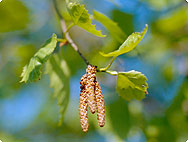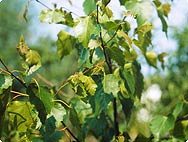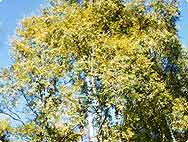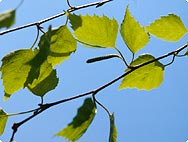A.Vogel search
When the internal search is activated, personal data such as your IP address is transmitted to our search engine Cludo. Data is thus transferred to a third country. Please click here if you want to display the internal search. You can find more information on data protection here: Privacy policy.
A.Vogel plant encyclopaedia
Betula pendula ROTH
Common Birch
History

Birch and aspen trees were to dominate the landscape following the Ice Age and the birch is still the most northerly tree. It is also the most characteristic tree of all countries indigenous to Teutons and Slavs. The German name for the tree contains the Indo-Germanic root “bharg” as well as the Gothic term “bairths”, meaning “to gleam” or “to be bright” and probably refers to the white bark. The Nordic words “bircha”, “biriha” and “bjork” developed from these roots. The botanical term betula does not originate from a Latin word but rather from a Celtic term, which has its root in the syllable “betu”, or “beth”. Shakespeare’s “Macbeth” in fact means “son of birch”. The Hebrew term “beth” means house, hence the words Bethlehem, Elisabeth etc.
The birch was highly regarded by the Celts, who used the tree in their initiation rituals; the Druids also used birch branches and dew to welcome noviciates into the fold. The birch is, moreover, the first tree in the Celtic calendar – a symbol for the period from 24 December to 20 January. The Celts also honoured the tree on 24 June, three days following the summer solstice. This was as important a date as 24 December, which marked the third day following the winter solstice.
The birch has been of great significance in both Slavic and Teutonic folk belief since the earliest times.
On Walpurgis Night (before May 1), holy Walpurga commands all witches, spirits and demons under her jurisdiction to come to her at Blocksberg Mountain, riding on broomsticks made of birch trees. Birch rods were considered to be life-giving and it was believed that illnesses could be transferred to the birch. In German folklore, the birch is regarded as a tree of life; this is reflected in the tradition of the maypole. In the 14th century, a pleasant-tasting ‘birch wine’ or ‘birch beer’ was made from the fermented sap of tapped birch trees. Elixirs made from the sap have been regarded as an invigorating spring cordial ever since.
Botanical characteristics

The Birch tree grows to a height of up to 30 metres; it sometimes has a tendency to grow like a bush. It has a characteristic, snow-white coloured epidermis of the bark which usually peels off in horizontal strips to reveal a harder black bark which covers the trunk right up into the crown. The branches slant upwards at a acute angle to the trunk, but many of the side branches are overhanging. The young branches are densely warted. The rhomboid-shaped leaves are very pale in spring, turning darker on the upper sides and pale greyish-green on the underside. They are doubly serrated at the edge and have strikingly dense venation. Unlike the leaves of Betula pubescens, the leaves of Betula pendula are not downy but are densely punctuated with glands. The male catkins are sedentary, elongated, cylindrical and hang down; they are up to 10 cm in length. The wind blows the fine pollen from these male catkins onto the female catkins, which are stemmed, cylindrical and only grow to a length of between 2 and 4 cm. At first the catkins are yellowish-green, turning pale brown later on. The scales of the fruit are brownish in colour.
The various species of birch are often confused. Betula pendula, which occurs in the wild all over central Europe, varies very little in shape and size. However, cultivated forms – such as the weeping birch, B. pendula f. tristis - sometimes have different shapes and grow to different heights.
The birch is in bloom from April to May.
Habitat

Birch is indigenous to Eurasia and can be found growing from the Mediterranean right up to a latitude of 65º in the north. The birch grows in dry areas among deciduous trees and conifers; it grows on dunes or heathland but also on moors and swampy regions. It prefers soil which contains peat or sand and iron, but otherwise the birch is a very undemanding tree and is even resistant to frost and lack of rain. As a “pioneer” tree, birch is capable of making a location habitable for other plants. Birch can be found growing at altitudes of up to 2,000 metres.
Preparation

A.Vogel/Bioforce makes use of fresh birch leaves, collected in late spring from birch trees growing in the wild. The leaves are then finely chopped and macerated in alcohol to produce a mother tincture. Apart from the leaves, the bark, young buds, juice, ash and, as Pliny also mentioned, the tar is used for medicinal purposes.